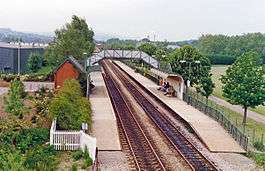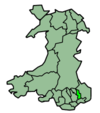Cwmbran railway station
| Cwmbran | |
|---|---|
| Welsh: Cwmbrân | |
 | |
| Location | |
| Place | Cwmbran |
| Local authority | Torfaen |
| Coordinates | 51°39′26″N 3°00′58″W / 51.6572°N 3.0160°WCoordinates: 51°39′26″N 3°00′58″W / 51.6572°N 3.0160°W |
| Grid reference | ST298958 |
| Operations | |
| Station code | CWM |
| Managed by | Arriva Trains Wales |
| Number of platforms | 2 |
| DfT category | E |
|
Live arrivals/departures, station information and onward connections from National Rail Enquiries | |
| Annual rail passenger usage* | |
| 2010/11 |
|
| 2011/12 |
|
| 2012/13 |
|
| 2013/14 |
|
| 2014/15 |
|
| History | |
| Key dates | Opened 12 May 1986 |
| National Rail – UK railway stations | |
| * Annual estimated passenger usage based on sales of tickets in stated financial year(s) which end or originate at Cwmbran from Office of Rail and Road statistics. Methodology may vary year on year. | |
|
| |
Cwmbran railway station (Welsh: Cwmbrân) is in the northeast of Cwmbran town centre, within five minutes' walking distance. It is part of the British railway system owned by Network Rail and is managed by Arriva Trains Wales, who operate all trains serving it. It lies on the Welsh Marches Line from Newport to Hereford. The station was opened at this site in 1986 to serve the commuter route to Newport and Cardiff, and shoppers to the town centre.
History
Historically, a number of railway stations served Cwmbran. The first station was opened by the Monmouthshire Railway and Canal Company in July 1852 or April 1878.[1][2] This closed on 11 March 1880 and a new station was opened on the same day by the Great Western Railway.[1][2] The station was located on a spur which linked the Monmouthshire Railway with the Pontypool, Caerleon and Newport Railway.[3] This closed to passengers on 30 April 1962[1][2] and to goods on 17 May 1965.[4] The first station, which had remained open for goods traffic, also closed on 17 May 1965.[4]
The Monmouthshire Railway line to Blaenavon ran to the west of the town.[3] The section between Pontypool and Blaenavon closed to passengers 30 April 1962, the mineral branches followed on 7 April 1969 and the branch to Talywain on 3 May 1980.[5] The section from Pontypool as far as Oakfield Siding near Cwmbran saw coal traffic until 1980.[6]
New station
The present station was opened by British Rail on 12 May 1986.[1][2] It is situated around 300 yards (270 m) to the south of Lower Pontnewydd railway station which closed to passengers on 9 June 1958 and to goods on 25 January 1965.[7][8][9]
Facilities
Refurbished facilities at the station were officially opened by Rhodri Morgan AM on Friday 14 March 2008. This included a larger car park, a new ticket hall, modern sheltered seating areas and new live departure boards like those seen at Newport. Previous to the refurbishment of the station, there used to be audio announcements, but these have since stopped. In addition to this, Torfaen County Borough Council have funded a limited Number 4 bus that serves the town centre and suburbs of Cwmbran, which is currently operated by Stagecoach in South Wales.
Service
Services that stop at Cwmbran in both directions are all operated by Arriva Trains Wales and include the hourly service between Manchester Piccadilly, Cardiff Central and West Wales and the two hourly service between Holyhead and Cardiff Central.[10] Most Sunday services only run on the former route (there are only two services each way to/from Holyhead).
| Preceding station | |
Following station | ||
|---|---|---|---|---|
| Pontypool and New Inn |
Arriva Trains Wales Welsh Marches Line |
Newport | ||
| Abergavenny (Northbound only) |
Arriva Trains Wales North-South "Premier" service |
Newport | ||
References
Notes
- 1 2 3 4 Butt 1995, p. 75.
- 1 2 3 4 Quick 2009, p. 142.
- 1 2 Conolly 2004, p. 43, section A3.
- 1 2 Clinker 1988, p. 36.
- ↑ Awdry 1990, p. 36.
- ↑ Cobb 2006, p. 141.
- ↑ Clinker 1988, p. 90.
- ↑ Quick 2009, pp. 142, 260.
- ↑ Butt 1995, p. 150.
- ↑ GB eNRT December 2015 Edition, Table 131
Sources
- Awdry, Christopher (1990). Encyclopaedia of British Railway Companies. Sparkford: Patrick Stephens Ltd. ISBN 1-8526-0049-7. OCLC 19514063.
- Butt, R. V. J. (1995). The Directory of Railway Stations: details every public and private passenger station, halt, platform and stopping place, past and present (1st ed.). Sparkford: Patrick Stephens Ltd. ISBN 1-8526-0508-1. OCLC 60251199.
- Cobb, M.H. (2006) [2003]. The Railways of Great Britain: A Historical Atlas. 1. Shepperton, Surrey: Ian Allan Publishing Ltd. ISBN 978-0-7110-3236-1.
- Clinker, C.R. (1988) [1978]. Clinker's Register of Closed Passenger Stations and Goods Depots in England, Scotland and Wales 1830–1980 (2nd ed.). Bristol: Avon-Anglia Publications & Services. ISBN 0-905466-91-8. OCLC 655703233.
- Conolly, W. Philip (2004) [1958]. British Railways Pre-Grouping Atlas and Gazetteer. Hersham, Surrey: Ian Allan. ISBN 978-0-7110-0320-0.
- Quick, Michael (2009) [2001]. Railway passenger stations in Great Britain: a chronology (4th ed.). Oxford: Railway and Canal Historical Society. ISBN 978-0-901461-57-5. OCLC 612226077.
External links
- Train times and station information for Cwmbran railway station from National Rail
- Pictures of Cwmbran Station from Railway Photography by 37430

